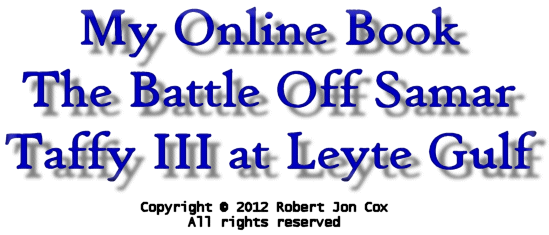
COMMENTS ARE ENABLED ON THE BOTTOM OF THE PAGE
Chapter 6
0630 to 0706
"GENERAL ATTACK"
Wednesday, October 25, 1944
|
Time-Line, Events, & Comments
|
0630 Rear Admiral Ziggy Sprague’s Task Unit 77.4.3, Taffy III, steams northward off the coast of Samar, course 355° T in formation 5 Roger. The individual warships of Taffy III issue the order for their crews to secure from General Quarters. All hands now stand down from morning air operations and settling into their morning routine.
|
TALK BETWEEN SHIP (TBS) |
|
| Unit CTU 77.4.3 (RADM Clifton Sprague) Escort Carriers (6 CVE) Escort Carriers (6 CVE) Screening Ships (3 DD, 4 DE) Screening Ships (3 DD, 4 DE) Screen Commander (CDR Thomas) |
Call-sign Taffy 3 Mercury 3 Great Danes Taffy 33 Small Boys Mercury 33 |
| Escort Carriers FANSHAW BAY ST LO KALININ BAY WHITE PLAINS KITKUN BAY GAMBIER BAY |
Call-sign BENDIX DERBY GEORGIA FIDO DEXTER CATNIP |
| Destroyers HOEL HEERMANN JOHNSTON |
Call-sign NEBRASKA DREADNAUGHT BRASSLOCK |
| Destroyer Escorts J.C. BUTLER RAYMOND DENNIS S.B. ROBERTS |
Call-sign OVERTURE FIGLEAF MONGREL JUGGERNAUGHT |
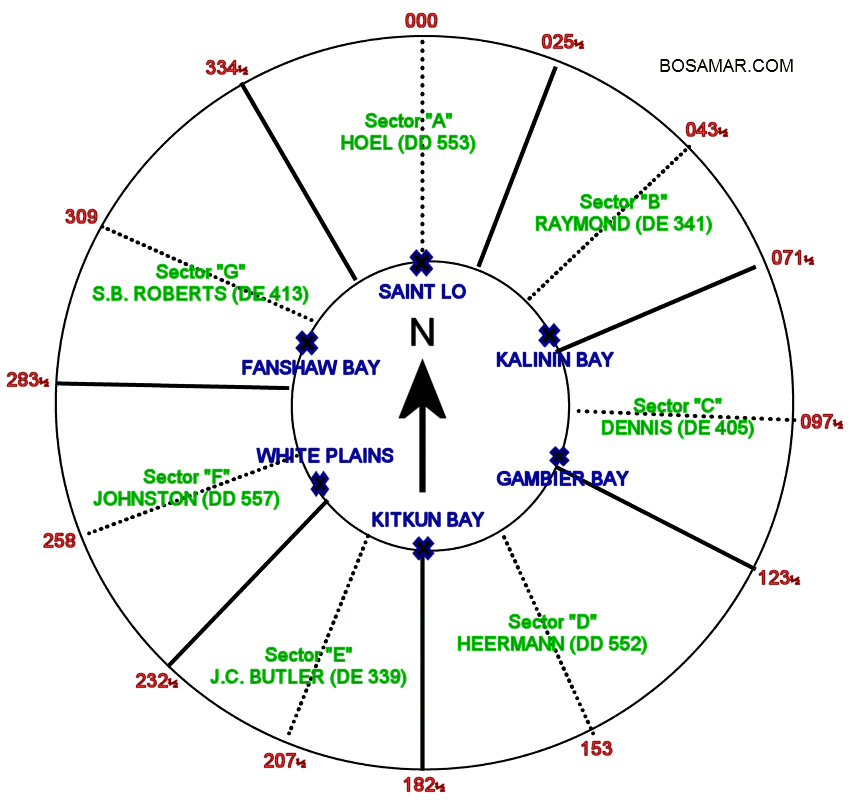
Formation 5 Roger Scale 1/2" = 1000 yardsFormation 5R placed the 6 CVEs on circle 2.5 The screening vessel within whose sector the course line takes station at the intersection of the designated circle with the median of his sector. Other screening vessels take stations on the designated circle at a linear spacing between ships of 4200 yards (or as directed) or as nearly as they can do so without leaving their sectors. When only five screening vessels are present a ten degree overlap beyond sector limits is permitted if necessary to close to 4200 yards spacing. |
| STATION | SHIP | SECTOR |
| 1 | SAINT LO (CVE-63) | 2.5000 |
| 2 | FANSHAW BAY (CVE-70) | 2.5300 |
| 3 | KALININ BAY (CVE-68) | 2.5060 |
| 4 | WHITE PLAINS (CVE-66) | 2.5240 |
| 5 | GAMBIER BAY (CVE-73) | 2.5120 |
| 6 | KITKUN BAY (CVE-71) | 2.5180 |
| STATION | SHIP | SECTOR |
| A | HOEL (DD-533) | 6334½-6025½ |
| B | RAYMOND (DE-341) | 6025½-6071½ |
| C | DENNIS (DE-405) | 6071½-6123½ |
| D | HEERMANN (DD-532) | 6123½-6182½ |
| E | J. C. BUTLER (DE-339) | 6182½-6232½ |
| F | JOHNSTON (DD-557) | 6232½-6283½ |
| G | S.B. ROBERTS (DE-413) | 6283½-6334½ |
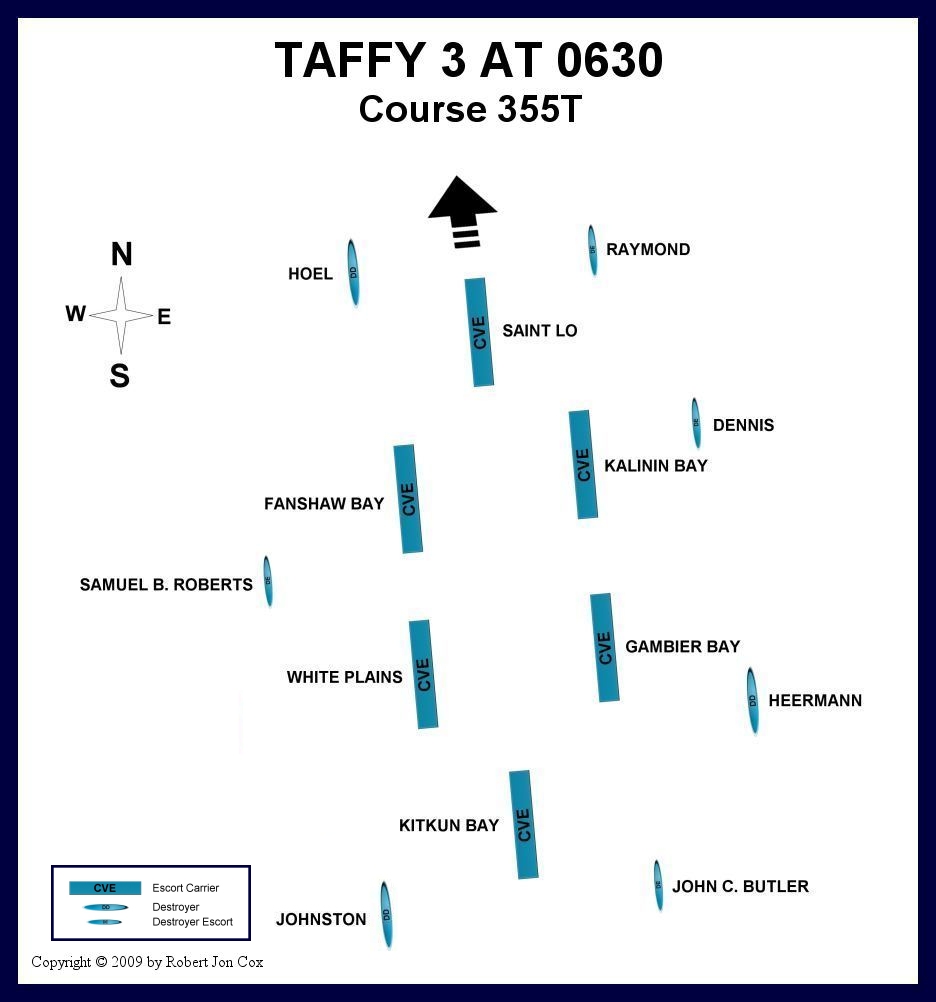
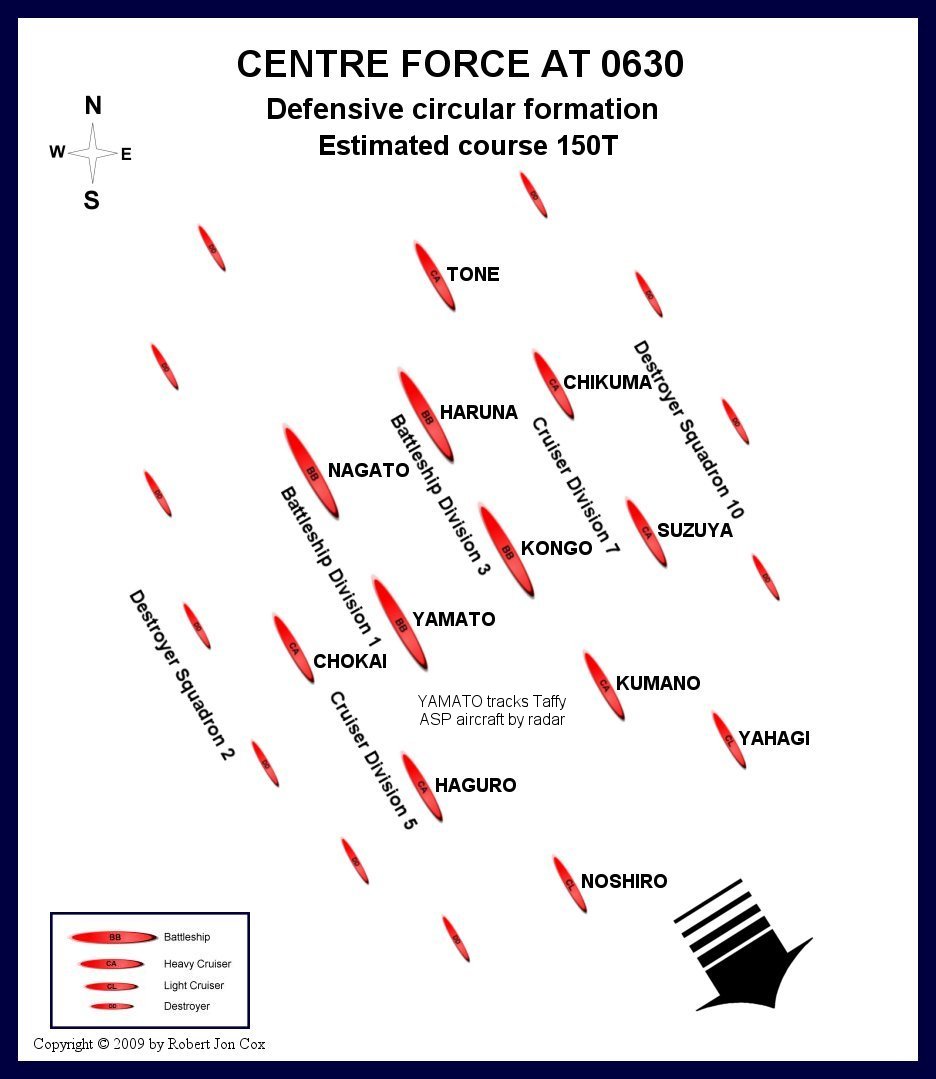
It's difficult to ascertain with any amount of certainty as to what formation Centre Force held at 0630. This is because at approximately 0530 they were ordered to form a defensive circular formation to maximize their anti-aircraft protection from air attacks, expected to arrive shortly.
0630 TBS - Mercury 3 v Taffy 3, "SIGNAL EXECUTE UPON RECEIPT CHARLIE FORMATION FIVE ROGER. GEORGIA AND FIGLEAF ACKNOWLEDGE" .... v GEORGIA, FIGLEAF, "WILCO OUT."
A/C This was Taffy III’s eighth day of duty at Leyte Gulf. The six small CVEs were taxed to their fullest, each day more difficult than the one before.
0633 Concentrating on the after action in the southwest, Taffy II requests permission from CTG 77.4 to launch a torpedo attack immediately if search planes locate Japanese warships retiring in Surigao Strait.
0635 Destroyer Escorts JOHN C. BUTLER and RAYMOND secure from battlestations.
EVENT Aloft on ASP, ENS Jensen's radioscope operator sights numerous blips to the northwest of Taffy III’s current position. Although it is out of his area of responsibility, he closes to investigate.
0637 The combat information center on CVE FANSHAW BAY receives Japanese voice transmissions on the inter-fighter direction network. The voices heard are definitely Japanese, and they sound very excited.
A/C This was thought to be an attempt by the Japanese to jam the inter-fighter direction network. By this point Centre Force may have been reacting to the approaching American reconnaissance aircraft or they may have already sighted some of the warships of Taffy III, hull-down.
0637 TBS - Taffy 3 v NEBRASKA, "INTERROGATORY CONDITION ONE." .... v Taffy 3, "ROGER OUT."
0640 Centre Force changes course to nearly due south.
| EVENT Ensign Jensen's TBM from CVE KADASHAN BAYof Taffy II visually sights the warships of Centre Force and closes further to investigate.
EVENT Ensign Jensen's TBM from CVE KADASHAN BAY comes within range of the anti-aircraft guns of the Japanese warships. Flak is put up in an attempt to down the shadowing U.S. aircraft. |
USS KALININ BAY (CVE-68) A plane on anti-submarine patrol from USS KADASHAN BAY reported to the OTC (Officer in Tactical Command) a task force composed of 4 enemy battleships, 6 cruisers, and numerous destroyers bearing 270° T distance 20 miles from this formation at 0654. The pilot of the plane definitely identified the task force as enemy. This information was conveyed to this ship over the Inter-fighter Director Net (37.6 mcs). Immediately after this report, excited Japanese voices were heard over the IFD net. A frequency test was made and it was found that the Japanese were directly on 37.6 mcs. On orders from the OTC General Quarters was sounded at 0658 and speed increased to flank... |
A/C Now that VADM Kurita knew Centre Force had been sighted, he expected another air attack from Third Fleet in very short order.
0643 Escort Carrier KADASHAN BAY's anti-submarine patrol aircraft closes the range further and identifies the warship types of Centre Force. Ensign Jensen reports its location to Taffy II's flagship CVE NATOMA BAY. Rear Admiral Sprague on Taffy III's flagship CVE FANSHAW BAY only receives a garbled transmission of ENS Jensen's report.
A/C Except for the garbled Japanese voice transmissions heard on the inter-fighter direction network, this was RADM Sprague's first true indication that something was awry.
|
EVENT Moments later, ENS Brooks of CVE ST LO sends an urgent voice report to Taffy III's flagship CVE FANSHAW BAY. "ENEMY SURFACE FORCE OF 4 BATTLESHIPS, 7 CRUISERS, AND 11 DESTROYERS SIGHTED 20 MILES NORTHWEST OF YOUR TASK GROUP AND CLOSING IN ON YOU AT 30 KNOTS." A/C ST LO’s Action Reported stated "An LASP plane from the ST LO piloted by Ensign Brooks of VC-65 reported contact with a Japanese Surface Force bearing 330° T twenty to thirty miles from Task Unit 77.4.3. This report was made to Commander Task Unit 77.4.3. The Japanese Force was estimated by Ensign Brooks as consisting of four BB, four CA, two CL and ten to twelve DD." This voice report was extremely accurate in Japanese force number and composition. |
RADM Clifton A.F. Sprague, USN Commander TASK UNIT 77.4.3 (Taffy III)
While the ack-ack was still chasing Brooks, we made visual contact with the Japs. Out of the fog loomed his big battlewagons... pagoda masts and all... and opened with their 14- and 16-inch (and 18.1-inch) guns at 25,000 yards. He had committed his whole task force to an attack on us." |
EVENT Rear Admiral Sprague hears the voice report from ENS Brooks. Annoyed by the transmission, he immediately orders, "...AIR PLOT, TELL HIM TO CHECK HIS IDENTIFICATION...."
A/C Rear Admiral Sprague believed ENS Brooks had spotted U.S. Third Fleet warships (Halsey). He theorized, as did all Seventh Fleet, Task Force 34 was guarding San Bernardino Strait and he therefore had no worries concerning his northern sectors. Thus, he had no knowledge that the entire Third Fleet was presently on its way north to engage VADM Ozawa’s decoy Northern Force. In addition, he believed Centre Force was presently on it's way back to Borneo after the severe pounding it received from Third Fleet's carrier aircraft the previous afternoon in the Sibuyan Sea. He had no reason to believe otherwise, until now....
|
0644 Centre Force visually sights the masts of four ships from Taffy III. The Japanese believe they have sighted destroyers. Next, three carriers, three "cruisers," and two more "destroyers" are also sighted. A/C The Japanese were not familiar with U.S. warship type recognition and most certainly they were not familiar with the recognition characteristics of the CASABLANCA Class escort carriers. The Pacific war was one of long-range carrier action. It was very seldom sailors aboard ships from either side got a good look at their enemies’ ships. The Japanese misidentification of the American warships would play an important part in their logic and tactics throughout the battle. EVENT After receiving flak from the Japanese BB HARUNA, ENS Jensen attacks the nearest ship and drops two depth charges, the only weapons at his disposal, on a heavy cruiser. Ensign Brooks follows suit in his TBM. |
VADM Matome Ugaki, IJN "At 0644, just before the order to form circular formation was issued, four masts, apparently destroyers, were suddenly spotted bearing 060° to port, 37 kilometers from YAMATO... This was followed by the sighting of three carriers, three cruisers, and two destroyers. It was a surprise encounter since no situation reports had been received since the previous night, and although we had long considered various measures for such an event, the ships, I thought, were extremely slow in reacting because of their lack of enemy information. Measures taken by the fleet headquarters, too, occasionally seemed lacking in promptness. At any rate at 0658 Battleship Division 1 opened fire with its forward guns at a range of 31 kilometers..." |
0645 Flak is sighted on the northwestern horizon by the lookouts of Taffy III. Alerted by the lookout reports, the radar operator on CVE FANSHAW BAY turns his radar set toward the reported flak and immediately afterwards, radar contact is made with the approaching ships of Centre Force. The Japanese fleet bears 330° T.
| 0645 A large unidentified surface force indication appears on SG radar bearing 300° T distance 23½ miles aboard CVE GAMBIER BAY.
EVENT Battleship YAMATO opens fire on the lurking U.S. aircraft. A/C Visual and radar contact with Centre Force was surprisingly made almost simultaneously by Taffy III from the signal and open bridges. Although visibility was very poor, the pagoda-like masts of the Japanese battleships could be seen astern. Taffy III was steering course 090° T. Shortly after the first contact report, the CIC aboard CVE ST LO gave the enemy forces range as "30,000 (yards) Closing." |
CAPT Walter V. R. Vieweg, USN "At about 0645 things commenced to happen. We intercepted a rather frantic voice transmission from a plane we believed was in an adjacent task unit, Task Unit 77.4.2. The gist of the message was that the Jap fleet was there somewhere about 40 miles from his home station. We didn't have to wait long to get additional information. One of our own task unit's anti-submarine patrol planes reported the presence to the northwestward, distance about 25 miles, of a Japanese fleet consisting of four battleships, eight cruisers and 13 destroyers. Almost simultaneously there reached me on the bridge a report from the radar room, and there was visible in the PPI on the bridge a force which could be nothing but enemy since we knew of no one that should be in a position 25 miles to the northwest of us. The radar plot confirmed the report from our anti-submarine patrol." |
A/C Upon sighting each other, confusion reigned high on both sides from the very beginning. The Japanese had no knowledge of U.S. escort carriers and they believed they were up against a much larger unit such as a task group. Taffy III was mistaken for one of Third Fleet's heavy fleet carrier task groups with an ample cruiser and destroyer screen. The Japanese over-estimation of the American opposition caused VADM Kurita to proceed cautiously.
0647 Steaming north on course 350° T at 14 knots DE JOHN C. BUTLER sights anti-aircraft fire on the horizon bearing 300° T. The Officer of the deck notifies the Commanding Officer, LCDR John E. Pace, USN (the only Regular Navy Commander of the four destroyer escorts in the Task Unit).
|
0648 Sobering confirmation is received aboard flagship CVE FANSHAW BAY. Ensign Brooks reports, "...THE SHIPS HAVE PAGODA MASTS...." the trademark tiered-towering masts of Japanese warships. 0648 Far to the north of the present unfolding and chaotic situation off Samar, VADM Kinkaid's message inquiry concerning the safeguard of San Bernardino Strait is received by ADM Halsey aboard BB NEW JERSEY. A/C This message was Seventh Fleet's inquiry sent earlier in the morning at 0412. Admiral Halsey's shocking reply is not received by Seventh Fleet until 0703. 0648 Battleship KONGŌ, very aggressively commanded throughout the entire engagement, independently turns eastward to pursue the American warships on course 080° T. The remaining warships of Centre Force continue on a southeasterly heading. |
CTU 77.4.32/COMCARDIV 26 Action Report It seemed unquestionable that the Japanese were aware of the presence of the CVE's operating off Leyte Gulf. However faulty their air reconnaisance, they could hardly avoid drawing conclusions from the regularly maintained schedule of air support by carrier planes from a time when the fast carriers were still in the Luzon-Formosa area. Presumably they felt confident of countering this threat with their own landbased air; in any case the risk was squarely faced. Therefore it appears unlikely that the damage inflicted by the CVE groups on the morning of the 25th was the decisive factor in forcing the Japanese to retreat. It is believed more likely that it was about this time - allowing for the usual delay in overcrowded communications - that they had word of the decisive defeat of the southern force in the night battle in the Gulf, that this new led them to overestimate our forces inside and to choose to retire. |
0650 Gun fire is observed in the distance off the port quarter of DE DENNIS. It is determined to be anti-aircraft fire of unknown origin.
0650 TBS - Taffy 3 v OVERTURE, "ANTIAIRCRAFT BURSTS BEARING 300, OVER." .... v Taffy 3, "ROGER OUT."
A/C BUTLER reports.
A/C Rear Admiral Sprague later stated in his Action Report:
"As it was, the only warning came from an Anti-Sub-Patrol TBM who reported being fired upon by a large group of enemy ships to the northward. This warning came when the enemy main body was only about 17 miles away, closing very rapidly on a nearly opposite course, and only shortly before major caliber shells began to fall in our midst. From this point on, it was a question of extracting the 6 CVE's, 3 DD's, and 4 DE's from a situation fraught with disaster."
A/C Although the Americans held the technological advantage of radar and improved sensors, the impossible had happened....they were surprised and brought into gun range by a vastly superior enemy force of front-line capital warships.
|
0650 Upon sighting the advancing Japanese armada, Destroyer JOHNSTON, one of three destroyers in Taffy III’s screen, passes word throughout the ship, "...WE ARE BEING PURSUED BY A LARGE PORTION OF THE JAP FLEET...." General Quarters is immediately sounded and all hands rush to man their battle stations. A/C Destroyer JOHNSTON had gone to General Quarters so many times during her brief life that her crew had resorted to calling her "GQ Johnny." A/C JOHNSTON is commanded by hard-charging CDR Ernest Evans, a man with a vigorous fighting instinct, known to be part Cherokee Indian. By no coincidence, he was nicknamed "Chief" at the Naval Academy, a term that caused some confusion within the Navy, as it is also the term used to address Chief Petty Officers, the U.S. Navy’s senior enlisted men. |
LT Robert C. Hagen, USNR "At about 0650 word was received by TBS "We are being pursued by a large portion of the Jap fleet." General quarters was sounded and this task unit headed in an easterly direction to launch planes. At this time the enemy fleet was about thirty four thousand yards distant bearing approximately 345 from us. The Japanese force was closing the range rapidly, their speed being 22 - 25 knots. The Captain immediately gave orders to the engine room to light off all boilers and make maximum speed. The Captain also ordered the engine room to commence making funnel smoke and ordered the smoke screen generator detail to make FS smoke. This ship then commenced zig zagging back and forth between the enemy and our own formation, laying heavy smoke screen." |
0650 TBS - Mercury 3 v Taffy 3, "SIGNAL EXECUTE UPON RECEIPT SHACKLE BAKER UNCLE EASY UNSHACKLE TURN. FIDO AND NEBRASKA ACKNOWLEDGE." .... v FIDO, NEBRASKA, "WILCO OUT."
A/C The task unit changes course to 090° T, due east.
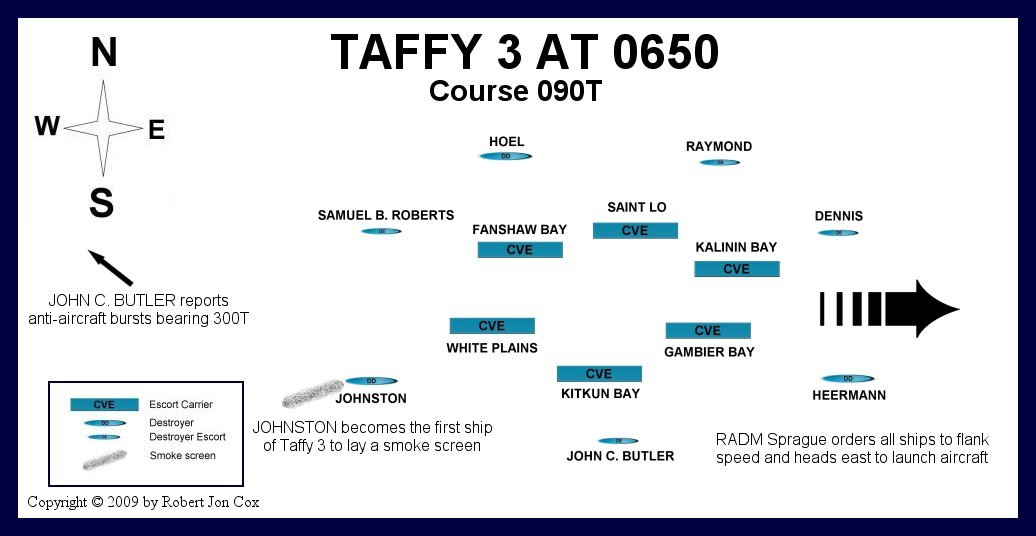
EVENT Destroyer Escort ROBERTS receives a report over TBS that Taffy aircraft have contact with an enemy task force. Immediately thereafter lookouts sight ani-aircraft fire to the Northwest. The tops of the larger Centre Force warships appear on the horizon, identified by ROBERTS Gunnery Officer as Japanese.
EVENT As the ships of Centre Force bear down over the horizon, their masts and superstructures begin to come into view. As the remaining ships of Taffy III become aware of the situation, General Quarters is sounded and the men of the task unit man their battle stations.
A/C At this point, the view from both sides must have been alarming. The thirteen ships of Taffy III, with the six escort carriers grouped in the middle, must have appeared as a formidable fleet to the Japanese. Believing six large carriers lay before them, they rationalized there must be a sizeable screening force too, including several cruisers. Likewise, the sight of the twenty-three warships of Centre Force by Taffy III must have seemed like the end of the world. For 898 of it’s men, it would be.
|
EVENT Destroyer JOHNSTON's captain, CDR Evans, orders his engine room to light off all boilers and make maximum spped. He also orders the engine room to commence making funnel smoke. Shortly thereafter, thick-black smoke pours from JOHNSTON’s stack and begins to trail aft of the ship. Due to the tropical humidity, the smoke lays low on the water, an ideal condition for the defending ships of Taffy III. A/C JOHNSTON was credited as the first ship of Taffy III to make funnel smoke....before all others. Commander Evans was credited with much that day. His ability to foresee unfolding events and commandeer each situation without prompting is clear indication of his professionalism, war fighting expertise, and is also evidence of his superb fighting character. |
CDR Ernest E. Evans, USN On October 27, 1943, at JOHNSTON's commissioning ceremony at the Seattle-Tacoma Shipbuilding Company, CDR Evans gave her crew fair warning about the type of ship he would be running. "...This is going to be a fighting ship. I intend to go in harm's way, and anyone who doesn't want to go along had better get off right now. Now that I have command of a fighting ship, I will never retreat from an enemy force...." |
0651 Rear Admiral Sprague sends an immediate dispatch to all ships of Taffy III over TBS, "JAP FLEET SIGHTED." He orders the task unit to course 180° T, then 090° T. All ships of the task unit quickly comply.
A/C Centre Force was approaching from bearing 330° T. The final course taken by Taffy III would enable the carriers to launch aircraft and at the same time, draw away from the bearing on the Japanese fleet. The wind, needed to launch the aircraft, was coming from 075° T to 080° T.
|
0652 From aboard BB YAMATO, Vice Admiral Kurita and his staff busily assess the threat which lays ahead. He orders the ships of Centre Force to advance at 24 knots to close the range on the American carriers. All ships reply and increase their speed accordingly. A/C The top speed of the slowest battleship, NAGATO, was just over 24 knots tops. This limited the pace of the other battleships, if they were to stay together and fight as an organized unit. This organization would be thrown out the window unintentionally shortly thereafter by another order issued by VADM Kurita at 0703. 0653 Several warships of Centre Force are seen on SL-1 radar scope aboard DE BUTLER bearing 290° T, range 33,000 yards. 0653 All warships of Centre Force are now ordered east to strike at the head units of Taffy III. 0653 Radio transmissions in Japanese are received aboard CVE ST LO on SCR 808. Anti-aircraft fire from the Japanese warships is seen. |
CTF 77 Action Report At 0653I/25 aircraft anti-submarine patrol of Task Unit 77.4.3 (Northern CVE Group) reported many enemy battleships, cruisers, and destroyers on a southerly course about 15 miles north and westward of the Task Unit. The first news of this enemy force was received aboard the flagship about 0724I/25 when Commander Task Unit 77.4.3 reported that he was under gunfire attack by four battleships, eight CA and many destroyers, at a range of about 30,000 yards. This was the first indication that the enemy's Central Force had succeeded in passing through San Bernardino Straits. Up to this time, from information available to Commander Seventh Fleet, it was assumed that Third Fleet forces were guarding the San Bernardino Straits in position to intercept and destroy any enemy forces attempting to come through. To confirm this assumption, Commander Seventh Fleet had sent a despatch to the Commander Third Fleet asking if he was guarding the San Bernardino Straits. Reply was not received until after the enemy forces were attacking our Northern CVE Group. |
0655 TBS - Mercury 3 v Taffy 3, "STANDBY TO LAUNCH ALL PLANES FOR ATTACK ON ENEMY FLEET 15 MILES ASTERN."
A/C Rear Admiral Ziggy Sprague reacts calmly, displaying the true professionalism which came with his years of combat-tested and command experience. All available aircraft are hurriedly readied to be launched from the decks of all six escort carriers.
|
0655 Aboard CVE GAMBIER BAY aircraft of Composite Squadron VC-10 spotted on the flight deck are prepared for immediate action, their engines running in preparation for launch. 0655 Lieutenant Commander Hansen of DE DENNIS informes the Gunnery Officer of enemy fleet. More anti-aircraft fire is observed on the horizon, forward on the port beam. A/C There were no blimps on DENNIS’ radar screen of the approached Japanese warships. The weather at this time was very squally which limited visibility. 0655 Lieutenant Commander Copeland on DE ROBERTS calls his crew to General Quarters. Full speed is ordered. 0656 TBS - Mercury 3 v Taffy 3, "LAUNCH ALL PLANES AS SOON AS POSSIBLE." 0657 TBS - Mercury 3 v Taffy 3, "CAUTION ALL PILOTS TO IDENTIFY ALL SHIPS BEFORE ATTACKING. DEXTER ACKNOWLEDGE." .... v DEXTER, "WILCO OUT." A/C Rear Admiral Sprague believed yet that the enemy warships sighted on the horizon may be American. |
CAPT Walter V. R. Vieweg, USN "Without waiting for instructions I commenced launching all planes on deck since I was under immediate threat of losing everything due to a shell hit on deck and setting the planes on fire. I managed to launch all ten remaining fighters on deck and in addition, the seven torpedo planes that were on deck. Unfortunately the torpedo planes were not fully loaded with bombs or torpedoes due to the situation. You see we had our planes loaded for missions involving direct support of shore troops and the loading for that was a combination of some planes with 100 pound bombs and others with 500 pound general purpose bombs. Our next scheduled flight, scheduled for 1000, was an anti-submarine patrol and we were caught in the process of shifting bombs and hence some of our planes had the depth bombs in them that they would be used at 10 o'clock, some of them had nothing in them and others still had the general purpose bombs in them." |
0657 Escort carrier GAMBIER BAY commences launching all aircraft.
0657 General quarters are manned on DE DENNIS. The 5"/38 caliber batteries are prepared to fire plain Common and AA Common for surface action and AA common and special projectile for anti-aircraft action. More gunfire is sighted astern.
|
0658 The order is given by the BB YAMATO to open fire with her front turrets. Battleship YAMATO opens the engagement with bellows from her massive 18.1-inch guns. The other Japanese warships open fire with their large caliber guns at 35,000 yards, approximately eighteen miles. A/C This was the first time YAMATO's main battery had been fired at American warships. With the largest active naval guns in World War II, the Japanese had high expectation as to what she could do with them. 0658 Full speed is ordered by OTC to all ships of the task unit. 0658 Splashes from heavy calibre shells fall close to DE ROBERTS and DD JOHNSTON. The shell fall is marked with green and purple dye. A TBS report is immediatedly made. 0658 TBS - Taffy 3 v JUGGERNAUGHT, "WE HAVE SPLASHES FALLING ASTERN OF US. WE ARE UNDER FIRE BY ENEMY FLEET. FULL SPEED AHEAD." A/C The destroyer escort SAMUEL B. ROBERTS, aka "JUGGERNAUGHT" was caught in the thick it as she steamed in the rear area of the task unit. 0658 From the escort carrier ST LO, splashes from the first enemy salvoes are observed. The CVE WHITE PLAINS appears to be under fire. At least three salvoes are observed. Two straddle CVE WHITE PLAINS and one is short. At least three more salvoes are observed short of flagship CVE FANSHAW BAY. 0658 Unaware of Taffy III's predicament and as earlier directed, CVE OMMANEY BAY of Taffy II launches a search plane to cover the approaches to San Bernardino Strait. A/C This was the reconnaissance patrol ordered by RADM Thomas Sprague, Commander Task Group 77.4, earlier that morning at 0330. Local rain squalls off Samar had significantly slowed the launch. 0658 Rear Admiral Sprague makes an urgent voice report, "TO ANY OR ALL", "WE HAVE ENEMY FLEET CONSISTING OF BBs AND CRUISERS FIFTEEN MILES ASTERN CLOSING US", and immediately thereafter, "WE ARE BEING FIRED ON". |
COMPOSITION OF CENTRE FORCE Battleship Division ONE Battleship Division THREE Cruiser Division FIVE Cruiser Division SEVEN Destroyer Squadron TWO Destroyer Squadron TEN |
A/C This was Taffy II's first indication of enemy forces being east of Samar. At this time the radar screen on CVE NATOMA BAY shows no indication of Taffy III and Centre Force.
EVENT Within seconds, an avalanche of various colored water plumes rise high in the morning air near the astonished ships of Taffy III. The seriousness of their dilemma now sets in.
A/C The first shells that rained down upon Taffy III landed between DD JOHNSTON, DE ROBERTS, and flagship CVE FANSHAW BAY, approximately 2,000 yards from the center of the task unit.
A/C Each Japanese ship fired shells which were marked with a different color dye that distinguished it’s salvos from the others. Battleship YAMATO’s shells were colored pink, BB KONGŌ’s were yellow. The other ships salvos were marked in red, blue, green, purple, and one ship had no color at all.
A/C Japanese fire control at this stage of the war was far behind that of the U.S. Navy. Because their fire control radar was unreliable, they devised a system of placing colored dye in their shells to mark the fall of each shot and to help distinguish each ships salvos. Once the shells exploded, spot checkers would distinguish their ship’s shell fall, note the range, and relay any range, bearing, and deflection corrections to their fire control personnel.
0659 TBS - "ALL CARRIERS FULL SPEED AHEAD. PREPARE TO LAUNCH ALL PLANES."
A/C Rear Admiral Sprague ordered the CVEs to their full speed, about 16 knots. A short time later he increased speed to flank, about 17.5-18 knots.
EVENT The Combat Information Center aboard DE ROBERTS plots the Japanese cruise force at 33 knots.
|
0700 TBS - Taffy 33 v Taffy 3, "MAKE SMOKE ASTERN OF US." A/C All screening vessels are ordered to make smoke. The admiral's initial orders were carried out as numerous colorful shell splashes pepper the water between the ship’s of his bewildered task unit. 0700 On DE ROBERTS thick black funnel smoke is seen coming from DD JOHNSTON. White chemical smoke is started aft on the fantail followed by black stack smoke from DD HOEL. A few minutes later ROBERTS commences making heavy black funnel smoke, which laid down on top of the white chemical smoke, adhering to the water's surface. |
USS KALININ BAY (CVE-68) 0654 Friendly aircraft reported an enemy task force of 4 battleships, 6 cruisers and numerous destroyers bearing 270< (T), 20 miles. All engines ahead at flank speed. General Quarters. c/c to 090< (T), 087< pac. All prisoners released from brig. Made smoke from stacks. Position at 0700. 11< 44' N . 126< 31' E. 0705 Sighted at 34,500 yds. a Japanese task force of 2 battleships, 3 cruisers, heavy, 8 destroyers. Enemy began shelling. Salvos hitting in water close by in all directions. 0706 Commenced launching and catapulting. 0725 Finished launching and catapulting. |
A/C ROBERTS Action Report stated, "...one of the most effective smoke screens that any one on the ROBERTS had ever previously observed. It was noticed that the smoke screen caused a slackening of enemy fire and a seeming uncertainty in their fire control."
0700 SL-1 radar scope aboard DE BUTLER now indicates eleven Japanese warships.
0700 Japanese Battleship Division One, YAMATO and NAGATO, pursue the American task unit on a southeasterly course with the warships of Destroyer Squadron TEN further ahead.
0700 Lieutenant Commander Aaron F. Beyer, Jr, USNR, Commanding Officer of DE RAYMOND orders the crew to battlestations. Upon orders from CTU 77.4.3 RAYMOND commenced making smoke.
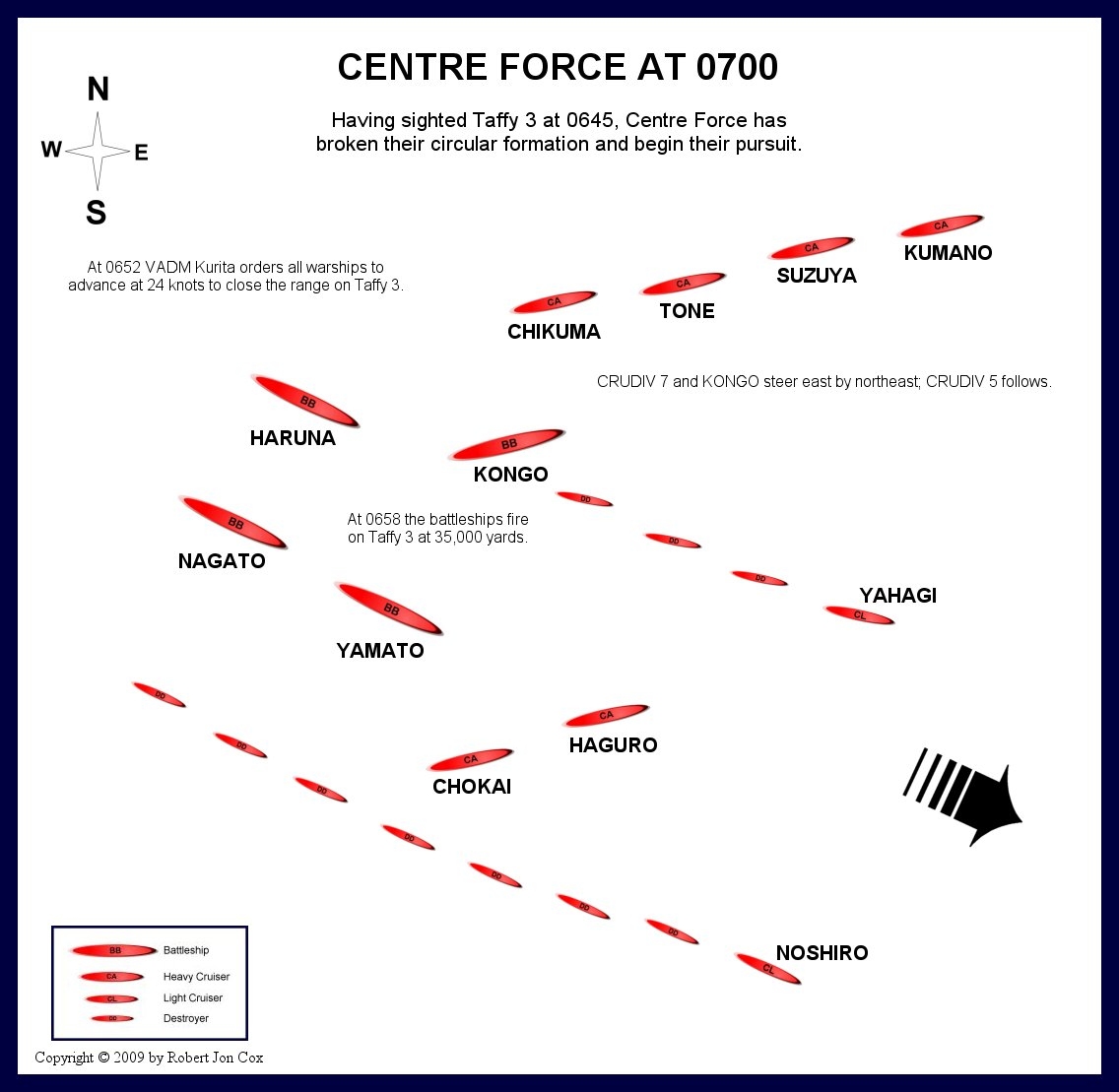
0700 Rear Admiral Thomas Sprague, CTG 77.4, requests and receives permission from Commander Support Air (for CTF 77) to launch all available torpedo planes and "go after them".
0701 TBS - Taffy 2 v Taffy 3,"COME IN PLEASE" . . . . "COME IN PLEASE".
A/C Under fire, Taffy III now attempted to contact its sister task unit to the south for assistance. A sense of urgency can readily be seen in this radio transmission.
0701 TBS - Taffy 33 v Taffy 3 "LAY SMOKE SCREEN ASTERN OF US." .... v Taffy 33, "WILCO OUT."
EVENT As shells fall around the ships of Taffy III, RADM Sprague sends an uncoded distress call to the other Taffies reporting his situation including a request for immediate assistance.
0702 Black funnel smoke begins to pour from the stacks of the escort carriers, destroyers, and destroyer escorts of Taffy III. In addition, the destroyers and destroyer escorts make white chemical FS and FM smoke on their fantails to add to the increasingly dense cover of smoke.
0702 Destroyer Escort RAYMOND observes shells falling astern of the ship and within the formation.
|
0703 After cautious evaluation of the tactical situation by he and his staff, VADM Kurita issues the order "GENERAL ATTACK" to all warships of Centre Force. EVENT As a result of his battle order, VADM Kurita consciously decides that the two destroyer squadrons will bring up the rear in a supporting action. The four battleships and six heavy cruisers of Centre Force are signaled to form pursuit disposition. A/C After several setbacks, VADM Kurita now believed things were going his way. He envisioned that an entire American carrier task group laid before him. He considered the sighted warships as a very befitting target for his warships. |
Admiral Kurita's decision for "general attack" was based upon the following logic:
2. Employing every trick to him, the enemy would try to put distance between himself and us (if possible maneuver himself to the windward of us) so that he could carry out a one-sided air action against us. 3. So that we could take advantage of this heaven-sent opportunity we should take after the enemy in present formation and at top speed. |
0703 Admiral Halsey replies to VADM Kinkaid's early morning inquiry (0412) received at 0648, concerning the location of Task Force 34 and the safeguard of San Bernardino Strait. To VADM Kinkaid’s disbelief VADM Lee’s Task Force 34 was not guarding San Bernardino Strait. Admiral Halsey’s reply read, "NEGATIVE. TASK FORCE 34 IS WITH CARRIER GROUPS NOW ENGAGING ENEMY CARRIER FORCE."
A/C The American fast battleships of Third Fleet were currently on their way north with the Third Fleet carriers preparing to engage VADM Ozawa’s decoy Northern Force.
A/C The misconstrued communications between Seventh and Third Fleets were the gravest American error committed during the entire Battle of Leyte Gulf.
0703 Escort Carrier KITKUN BAY completes the launching of eight FM-2 Wildcat Fighters from Composite Squadron VC-5.
|
A/C Fortunately, these planes had been warming up prior to the enemy being sighted. The first General Motors FM-2 fighter was launched shortly after 0656. 0703 TBS - Taffy 33 v JUGGERNAUGHT, "DO YOU WANT US TO COME BACK AND HELP YOU ON SMOKE SCREEN." .... v Taffy 3, "AFFIRMATIVE" 0703 The destroyers and destroyer escorts of Task Unit 77.4.3 start laying a smoke screen. EVENT Battleship YAMATO continues to leash out at the fleeing escort carriers of Taffy III with her massive 18.1-inch guns. EVENT Aboard BB YAMATO, Vice Admiral Kurita optimistically sends the following message to ADM Toyoda and his staff at GHQ in Tokyo: "BY HEAVEN-SENT OPPORTUNITY WE ARE DASHING TO ATTACK THE ENEMY CARRIERS." |
CTU 77.4.3/COMCARDIV 25 Action Report The events of the morning of the 25th of October proceeded along routine lines from midnight until 0645. Sunrise was to be at 0614. The sea was calm with 6 to 8 knots of wind from a north-easterly direction. About three tenths cumulous clouds were present with widely scattered showers. At 0530 the Target Combat Air Patrol of 12 VF had been launched, and at 0607 the Support Group of 4 VT, Target Anti-Submarine Patrol of 2 VT, plus local Combat Air Patrol and local Anti-Submarine Patrol had been launched. All target missions had departed for the target area. At 0645 AA gunfire was observed and two minutes later an anti-sub patrol plane reported he was being fired upon by an unidentified group of BB and CA bearing 340 degrees distant about 20 miles. Course was immediatedly changed to 090, which was close enough to the wind to permit launching and still avoid further closing of the contact, and flank speed ordered. |
A/C Vice Admiral Kurita was under pressure to react quickly. At the time, he did not know the exact composition of Taffy III, believing he was up against Third Fleets heavy ESSEX Class fleet carriers with BALTIMORE Class cruiser and destroyer escorts. Believing the first air attacks against his ships would come from this force, his plan was to destroy the carrier flight decks first, before their air power could be brought to bear upon his fleet.
|
EVENT The heavy ships of Centre Force’s battleship and cruiser divisions, previously maneuvering to form an anti-aircraft defensive circular formation, now rush forward to attack Taffy III independently of each division and without coordination. A/C If it was Third Fleet’s heavy carriers they had sighted, their logic was they had to destroy the flight decks immediately, before their aircraft could be launched to strike against them. A/C When the word "general attack" was received, some of the warships of Centre Force charged forward as divisional units; others, BB KONGŌ specifically, acted independently. Hindsight tells us that VADM Kurita should have formed battle line to deal with the slow moving escort carriers. |
VADM Matome Ugaki, IJN "At about 0700 it was said that there were six carriers. From 0706 we advanced generally on an easterly course and employed our secondary guns at the enemy who appeared from behind the smoke. It was generally about this time that one carrier (WHITE PLAINS) was sunk, one carrier (ST LO) was heavily damaged, one cruiser (HOEL) was sunk, etc. We were now rapidly approaching the enemy - the range by radar was 2200 meters and visibility was gradually improving from the east. We hoped to destroy the enemy at one blow if he came out from behind the smoke. In the meantime we were attacked by enemy aircraft. Several salvos from medium caliber enemy guns fell near YAMATO, and two shells hit the starboard after gallery and outer boat shed..." |
EVENT The four IJN heavy cruisers of Cruiser Division Seven, KUMANO, SUZUYA, TONE, and CHIKUMA, form up and begin their pursuit of the Americans in earnest. Their course takes them almost due east, to the north side of the fleeing American warships. The remaining Japanese heavy cruisers, HAGURO and CHŌKAI of Cruiser Division Five, follow CRUDIV 7.
EVENT Vice Admiral Kinkaid, Commander Seventh Fleet, receives an uncoded distress call from RADM Sprague stating Task Unit 77.4.3 is under attack by heavy warships of the Japanese fleet.
EVENT Rear Admiral Felix Stump, Commander Task Unit 77.4.2 (Taffy II), hears RADM Sprague’s uncoded distress call on board his flagship CVE NATOMA BAY. He replies to RADM Sprague with a shrill in his voice, "DON’T BE ALARMED ZIGGY, REMEMBER WE’RE BACK OF YOU, DON’T GET EXCITED, DON’T DO ANYTHING RASH!"
A/C Rear Admiral Stump’s Taffy II was currently steaming about 20-25 miles southeast of RADM Sprague’s task unit. The thought of his fellow Taffy's predicament had shaken him. His task unit would have the luxury of staying on the edge of the battle between Centre Force and Taffy III for the duration of the battle. As such, he was able to respond with a controlled urgency and send off balanced air attacks, unlike his cornered counterpart to the north.
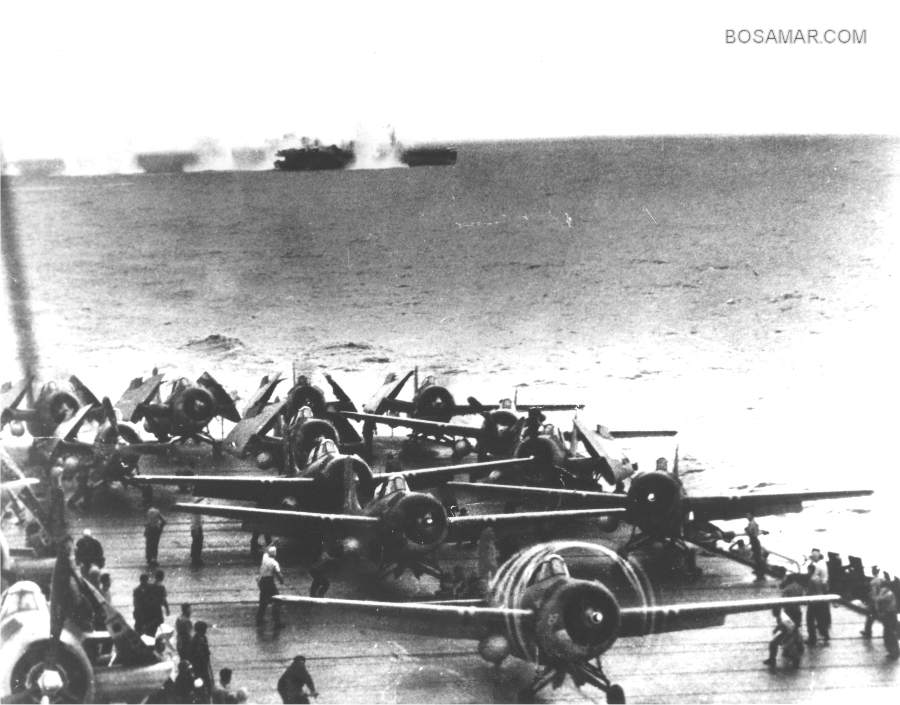
U.S. Navy Photograph
Escort carrier USS WHITE PLAINS (CVE 66) (in background) under fire off Samar
|
0704 Escort Carriers WHITE PLAINS and flagship CVE FANSHAW BAY, nearest to the Japanese, are both straddled by kaleidoscopic 14-inch salvos from battleships HARUNA or KONGŌ. These near-misses explode so violently CVE WHITE PLAINS is rocked mercilessly, causing her steering and electrical power to temporarily fail. With a loss of electrical power, her steering is disabled and she looses steerage way. EVENT Thick black funnel smoke from CVE WHITE PLAINS misleads the Japanese gunners who believe she is now on fire and disabled. They change targets and their heavy salvos are now diverted to the neighboring escort carrier ST LO. EVENT Escort Carrier ST LO and the remaining CVEs come under increasingly heavy caliber fire from the battleships and heavy cruisers of Centre Force. As 18.1, 14, and 8-inch shells rain down on the ships, the number of multi-colored shell splashes reaches their pinnacle. |
LCDR Edward J. Huxtable, USN To summarize, seven VT and ten VF type planes were launched with all possible speed commencing at about 0655. (Note: There was a TCAP flight over Leyte launched at 0500 which is why there were fewer planes launched than the total complement. There were also a couple of TBM types that were never able to be launched.) Within one half hour two more VT were launched loaded with torpedoes. As long as the planes remained under 1000’ it was easy to spot the enemy warships, but to make an effective attack on these ships under the very cloudy and rainy weather conditions altitude has to be gained. Some time was required before even a fairly good try could be made due to the weather. Since the flagship of the disposition was ordering immediate attack, Lt. Comdr. Huxtable made the best of a very poor situation and finally found a hole in the clouds for the few torpedo planes he had loaded to make an attack. Due to mechanical or personnel failures in failing to release the bombs on the first try, second and third runs had to be made to properly get rid of the bombs. |
A/C Rear Admiral Sprague, "in the ultimate of desperate circumstances" later remarked:
"...the enemy was closing with disconcerting rapidity and the volume and accuracy of fire was increasing. At this point it did not appear that any of our ships could survive another five minutes of the heavy-caliber fire being received...."
The warships of Taffy III were truly in a tight predicament.
EVENT Destroyer JOHNSTON, the closest DD to the Japanese, travels in the rear of Taffy III zig-zagging and laying thick-black smoke as she goes. The flash of the guns from the Japanese ships coming over the horizon can clearly be seen by the naked eye. To the relief of many of her crew members, JOHNSTON is heading away from the Japanese fleet as it appears to rapidly gain on the slower ships of Taffy III.
EVENT Commander Evans, Destroyer JOHNSTON's commanding officer, passes word to his crew, "...PREPARE TO ENGAGE MAJOR PORTION OF JAPANESE FLEET...." Destroyer JOHNSTON is immediately turned towards the nearest column of Japanese warships, Cruiser Division Seven. She proceeds on an intercept course to engage heavy cruisers KUMANO, SUZUYA, TONE and CHIKUMA, without orders to do so.
A/C The closing speed between JOHNSTON and the enemy cruiser division was estimated to be greater than 60 knots.
EVENT Far to the north of the present action between Centre Force and Taffy III, shortly after 0700, VADM Mitscher orders VADM Lee to form battle line, Task Force 34. Battleships WASHINGTON, ALABAMA, IOWA, NEW JERSEY (Halsey’s flagship), MASSACHUSETTS, and SOUTH DAKOTA, heavy cruisers WICHITA and NEW ORLEANS, light cruisers VINCENNES, MIAMI, BILOXI, SANTA FE, and MOBILE, and eighteen destroyers drawn from all three task groups.
EVENT Task Force 34 is now assembled to engage the Japanese Northern Force in a surface action. Admiral Halsey, unaware of Taffy III’s current predicament, is focused on his upcoming engagement with VADM Ozawa’s decoy force.
A/C The consistency of Task Force 34 had now changed from the original battle plan message Admiral Halsey had sent the evening of 24 October. Now, all six fast battleships would be formed as the core of VADM Lee’s battle line.
0705 Destroyer Escort DENNIS commences making FM chemical smoke from her Mark 6 smoke generators. Large caliber projectiles are sighted landing within the formation.
A/C According to her Action Report DENNIS used the #35, 8 minute nozzle on her smoke generators.
0705 CTG 77.4 orders Taffy II to, "LAUNCH AS MANY VT AND VF AS POSSIBLE".
|
0705 Escort carrier GAMBIER BAY completes the launching of all Composite Squadron VC-10 aircraft spotted on her flight deck. Four more aircraft, TBM-1C Avenger Torpedo-bombers, remain below on the hangar deck. Of these aircraft, two are launched with torpedoes, three with bombs, two with depth-charges, and two with no weapons at all. A/C Although GAMBIER BAY managed to send up many aircraft, nearly her entire aircraft complement, only the two armed with torpedoes were a real threat to Centre Force. The remaining aircraft, impotent as they were, concentrated on harassing the Japanese fleet and slowed their advance. 0706 Japanese Battleship Division One, YAMATO and NAGATO, change course to 070° T. |
USS WHITE PLAINS (CVE-66) Action Report
|
0706 Task Unit 77.4.1 commences launching additional strike planes.
0706 Still under increasingly heavy fire from Centre Force, the van of Taffy III ducks into a heavy rain squall which immediately reduces visibility to less than half a mile....
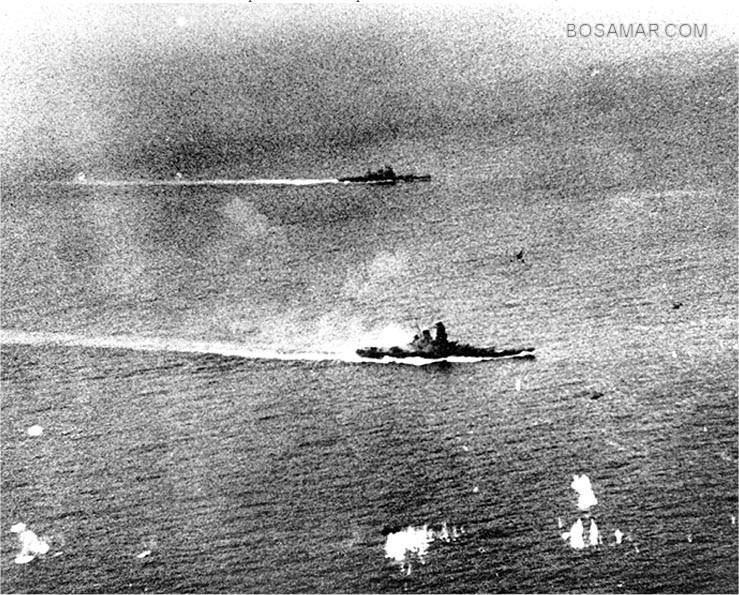
National Archives Photograph
Imperial Japanese Navy battleship HIJMS YAMATO (foreground) with
Battleship Division ONE mate HIJMS NAGATO (background)
at the Battle Off Samar, October 25, 1944